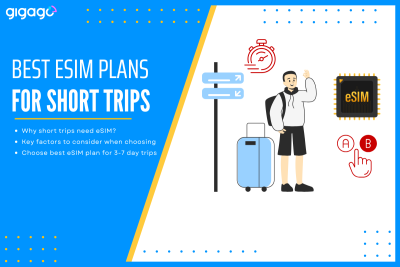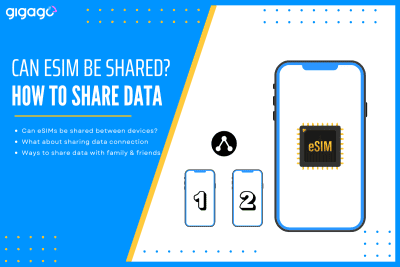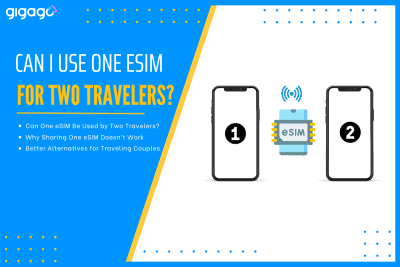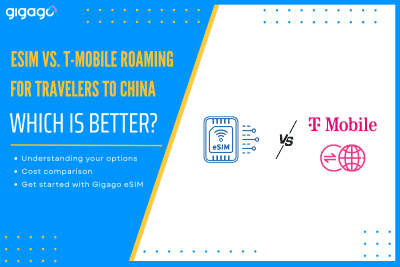Traveling for a short trip, typically for 3- to 7-days, drastically changes the rules of connectivity. The traditional solutions like expensive carrier roaming or time-consuming local SIM buying are simply impractical when time time is precious. This is where eSIMs take the picture. The eSIM (embedded because it is a digital solution that solves the […]
Comparison of eSIM vs Roaming Plan: Which is Better?
Travelers, especially frequent travelers, are often concerned about which connectivity option to choose is cost-effective and convenient. Relying on roaming with the home mobile network operator is a traditional way to stay connected while abroad. But it is not the best option so far. Roaming is costly and restricted in terms of coverage. There are better alternatives. In this article, we provide a detailed comparison of eSIM vs roaming plan that covers costs, coverage, data speeds, and ease of use. This aims to help you make an informed decision on which option to choose to avoid roaming charges and stay connected while traveling internationally.
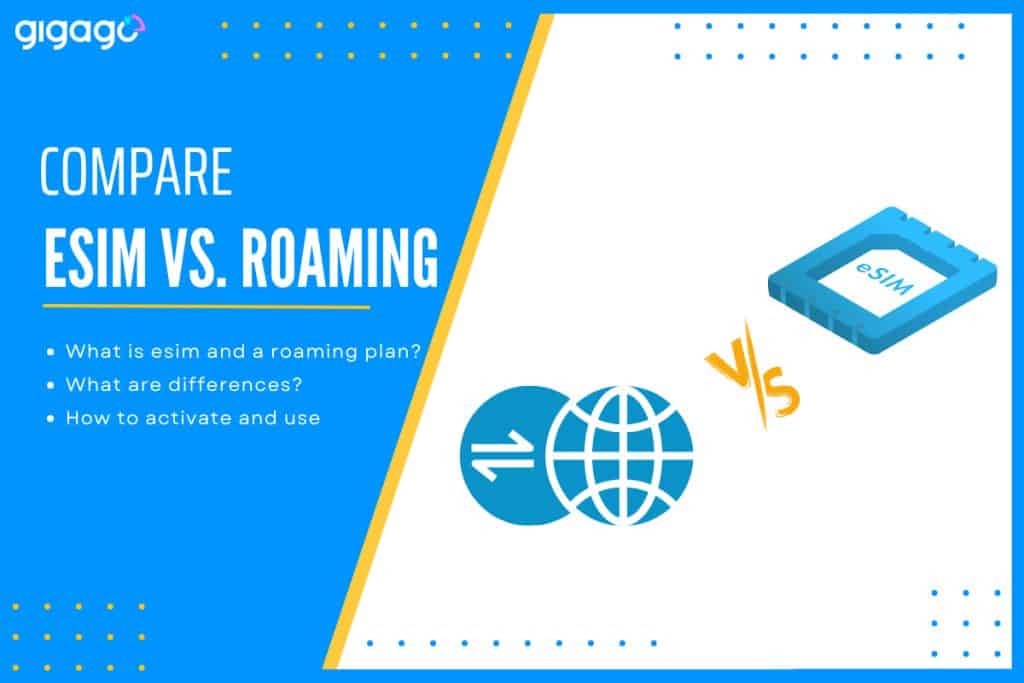
In this article
I. Understanding The eSIM And Data Roaming
Understanding about an eSIM and a roaming plan is essential before learning about differences between these connectivity options.
An eSIM: is part of the integrated circuit of a mobile device. It is a small chip in the motherboard of a phone that enables you to make calls, SMS and get mobile Internet without the need of a physical SIM card. See more details about an eSIM for travelers in our full guide.
A roaming plan: allows you to use your home phone number and plan in a foreign country with a daily fee that often includes an allowance for calls, texts and mobile data. Using a roaming plan, you will play the role of a guest on a foreign carrier’s network. Your home network carrier will “borrow” the infrastructure and services of the foreign network carrier with a fee. We explain about roaming in detail in our phone and data roaming guide.
II. What Are Differences Between eSIM And Data Roaming?
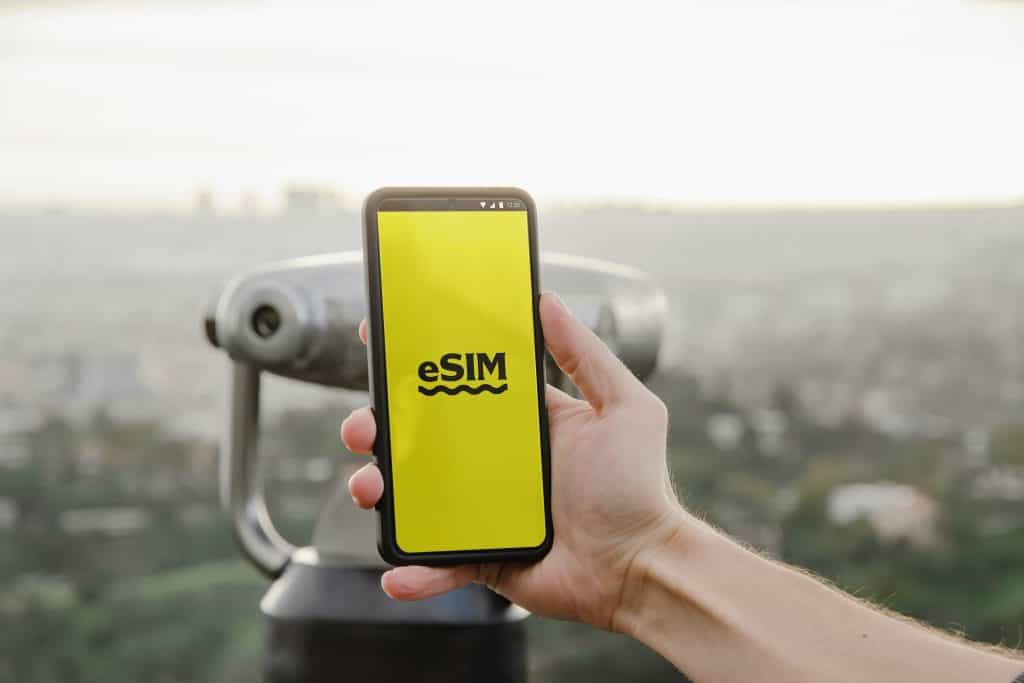
The differences between eSIM and data roaming is mentioned in this table:
| Criteria | eSIM | Data Roaming Plan |
| Costs | Generally cheaper than data roaming, especially for long-term travel or high data usage | Can be expensive, especially if you exceed your data limit |
| Coverage | Wider coverage than data roaming, as eSIMs can connect to local networks in over 100 countries | Limited to the coverage area of your home network provider |
| Data Speeds | Typically offers faster data speeds than data roaming | Data speeds may vary depending on your home network provider and the local network you connect to |
| Ease of Use | Easy to set up and use, no need to purchase a local SIM card or rent a portable Wi-Fi device | Requires you to enable data roaming on your phone and may involve additional setup steps |
To help you have a practical view about differences between an eSIM and a roaming plan, here we make a table comparing how the data speed and coverage of an eSIM and a data roaming in different popular countries:
| Country | eSIM data speed | Roaming data speed | eSIM coverage | Roaming coverage |
|---|---|---|---|---|
| United States | 5G | 4G LTE | Nationwide | Nationwide |
| United Kingdom | 5G | 4G LTE | Nationwide | Nationwide |
| France | 5G | 4G LTE | Nationwide | Nationwide |
| Spain | 5G | 4G LTE | Nationwide | Nationwide |
| Germany | 5G | 4G LTE | Nationwide | Nationwide |
| Japan | 5G | 4G LTE | Nationwide | Nationwide |
| South Korea | 5G | 4G LTE | Nationwide | Nationwide |
| Australia | 5G | 4G LTE | Nationwide | Nationwide |
| Canada | 5G | 4G LTE | Nationwide | Nationwide |
| Mexico | 4G LTE | 3G | Nationwide | Nationwide |
| Brazil | 4G LTE | 3G | Nationwide | Nationwide |
| India | 4G LTE | 3G | Nationwide | Nationwide |
| China | 5G | 4G LTE | Nationwide | Nationwide |
This chart shows that eSIMs and roaming plans offer similar data speeds and coverage in most countries. However, there are still some exceptions. For example, eSIMs tend to offer 5G data speeds in more countries than roaming does. In addition, roaming coverage may be more limited in some countries, especially in rural areas.
Overall, we can see that eSIM offers many advantages over data roaming, including lower costs, wider coverage, and faster data speeds. However, it is important to consider the specific country you will travel to, your needs and device compatibility before making any decision.
III. How Much Is An eSIM vs Roaming Plan?
An eSIM for tourists is often prepaid, which allows you to know exactly what you get. Therefore, there will not be any unexpected charges. A typical eSIM plan starts from $4. You also have many eSIM plan options to choose from.
Note that if the data costs of a country/region are higher, then eSIM providers will charge higher data rates for that place.
A roaming plan costs you a daily fee for continually accessing your mobile services abroad. The roaming rate varies by region. For example, in North America, the roaming rates is from $12 to $15 per day.
Note: Roaming charges are counted at a premium. So, the fact is, you will pay the same amount whether you use 1GB or 3GB of data in one day. If you are wondering how much data is enough for your international trip, we suggest you refer to our guide on deciding the data amount you will need for travelling abroad.
IV. When To Choose eSIM vs A Roaming Plan

You should choose an eSIM when:
- You travel to multiple countries and want to avoid the hassle of buying SIM card in a foreign country
- You prefer easy activation because eSIM allows you to activate an eSIM remotely through a website or an app, therefore removing the need to visit a physical store to buy and set up the SIM.
On the other hand, you should choose a roaming plan when:
- You prefer a hassle-free solution without having to set up any additional thing
- You travel on a short trip and the roaming rates are reasonable.
- You require extensive coverage: Some destinations, especially remote or less-traveled ones, do not support eSIM technology or have limited eSIM availability. Relying on a roaming plan will warrant that you have network coverage wherever you go.
- You need a significant data allowance: if you are a high data user, roaming plans or data packages will be more cost-effective than buying a local eSIM/SIM card.
After all, choosing an eSIM or a roaming plan depends on your own needs, travel destination and the available options between your home carrier and local carriers. You should compare the costs, coverage and convenience before making any decision.
V. Where To Buy eSIM vs Roaming Plan?
To buy eSIM, you have two options:
- buying from your home network carrier directly. or
- buying from a reputable eSIM provider like Gigago.com, which is the leading global eSIM provider giving you access to affordable eSIMs for more than 200 countries and territories in the world.
According to many experienced travelers, it is recommended to buy an eSIM for travel from an eSIM retailer. The purchase process does not require any personal documents for registration.
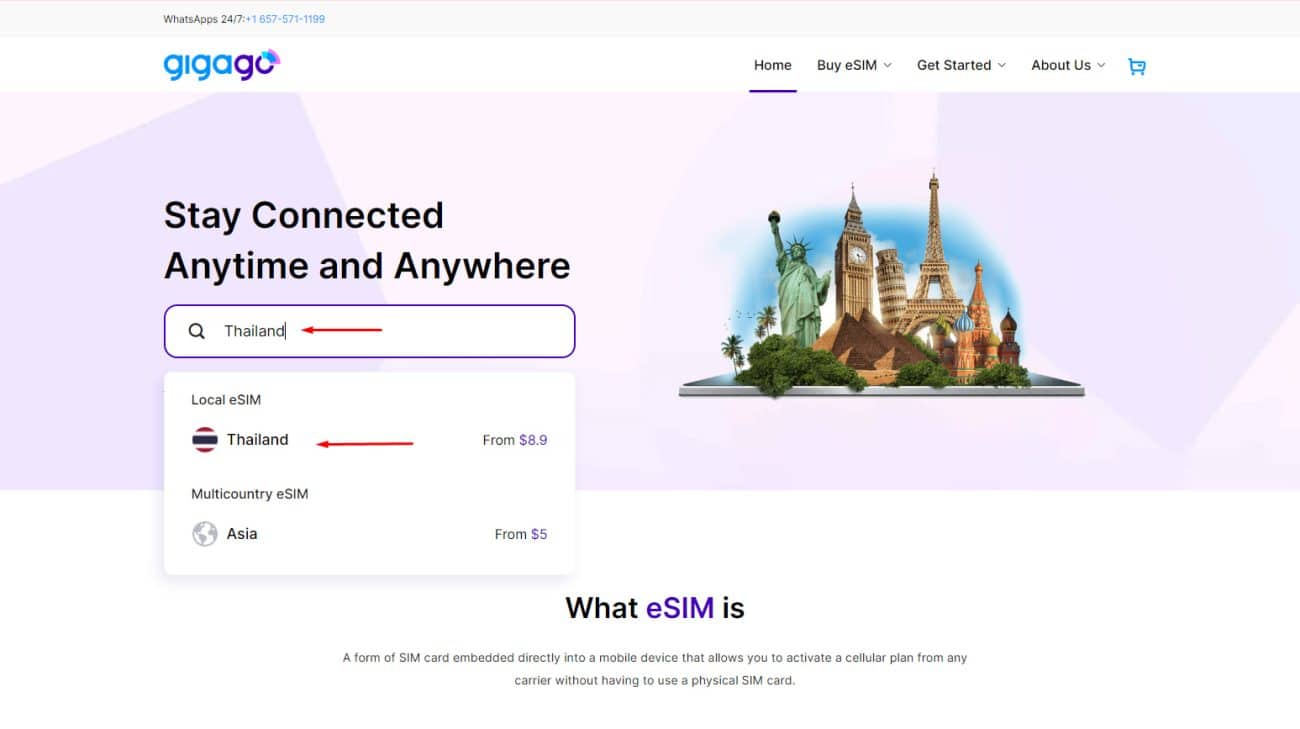
To buy a roaming plan, you need to contact your home network carrier to inform the destination you travel to and the duration of your trip. This can be done 100% online. However, be careful that you may cope with a surprise roaming bill if you do not stick to your itinerary.
VI. How To Activate An Esim vs Roaming Plan?
Activating an eSIM involves in scanning a QR code sent to your email address that you register when buying the eSIM. This activation process only takes several minutes.
Here is the quick guide to activate an eSIM:
- Use an unlocked phone to scan the QR code in your email
- Alternatively, enter an activation code sent from your eSIM provider (also in the email)
- Turn on your eSIM line and data roaming (without being charged a roaming fee)
- Enjoy Internet connection when arriving at your destination
To see detailed steps to activate eSIM on different mobile devices, visit our full eSIM Activation Guide.
A roaming plan will automatically activate and expire based on the duration of your travel. When you arrive at your destination, turn on data roaming to activate the roaming plan and start using your mobile services abroad. If you want to extend your trip, you may be charged an extra fee.
See more details on what data roaming is to understand more about roaming plans.
VII. How To Use An Esim vs Roaming Plan?
How to use an eSIM: Using an eSIM for traveling is simple. Because eSIMs work 100% digitally, you just need to buy an eSIM plan for the country you travel to, set up and activate the eSIM, and get connected to a supported mobile network in the destination.
Requirements: an unlocked and eSIM-compatible device. Fortunately, most smartphones since 2018 support eSIM technology.
How to use a roaming plan: Using a roaming plan is very easy. First, you need to contact your network provider before departure, and request an international roaming plan for your travel. After arriving at your destination, you just need to switch on the roaming button and start using your mobile phone abroad. However, with this option, there are probably limits on data, calls and SMS because you are locked to your network provider.
Requirements: no need for an unlocked phone.
VIII. eSIM vs. Roaming Plan – Which Is Better?
Based on the differences along with the way to buy, activate and use eSIM vs roaming plan above, we advise you to choose an eSIM over a roaming plan.
The reasons are:
- eSIM is more flexible. You can switch between different mobile network carriers and plans without having to insert in and swap out a physical SIM card.
- eSIM can work with multiple devices. You can use the same mobile phone number and data plan across different devices at a time, like your smartwatch, tablet or smartphone.
- eSIM is easy to activate: you can activate an eSIM remotely with Internet access. The activation process is also quick and convenient. No need to visit a store to buy a physical SIM card or wait for it to be shipped. As a result, you can save time and effort.
- eSIM is cheap for frequent and long-term travel. If you travel frequently or for a long period, using an eSIM helps you avoid costly roaming charges and also make use of prepaid plans with local rates at your destination.
- Multiple SIMs can be stored in one device. Most smartphones which support eSIM function allow you to store up to 8 eSIM profiles in a device. But be noted that only one profile is activated at a time.
However, it is also worth noting that eSIMs also have disadvantages, but they will be fixed in the near future. Some current disadvantages of eSIM are:
- Not all phone models work with eSIM. Only devices equipped with eSIM technology can do so. Fortunately, most smartphones since 2018 support eSIM technology.
- The local network you are going to use must also support eSIM technology.
- eSIM plans are rather more expensive than physical ones, but still cheaper than roaming fees.
Good news is that eSIM is developing quickly, many of these disadvantages will be removed in the near future.
So which is right for you? An eSIM or a roaming plan?
To conclude, the best option for you will depend on your individual needs and circumstances. If you travel frequently and want the most secure and convenience option, an eSIM is a wise choice. But if you are on a budget, have an eSIM-incompatible phone, or travelling to a country where eSIMs are not supported, roaming may be a better option.
